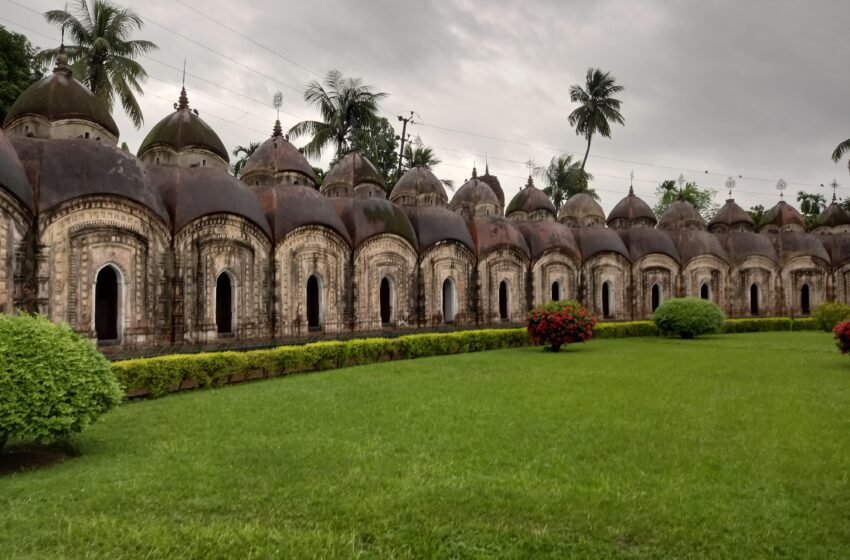Unveiling the Mystique of Kalna 108 Shiv Temple: A Spiritual Journey

Exploring the Sacred Splendor: Unraveling the Mystique of 108 Shiva Temples at Ambika Kalna, West Bengal
Nestled amidst the tranquil environs of West Bengal, India, lies a pilgrimage site steeped in divinity and architectural grandeur – the 108 Shiva Temples at Ambika Kalna. Constructed in 1809 by Maharaja Teja Chandra Bahadhur, these temples stand as a testament to the unwavering devotion and artistic brilliance of the bygone era. In this SEO-friendly blog, we embark on a spiritual journey to explore the origins, significance, worship rituals, architectural marvels, and legacy of these sacred edifices.

The history of the 108 Shiva Temples at Ambika Kalna traces back to the early 19th century, during the reign of Maharaja Teja Chandra Bahadhur. Inspired by a divine vision, the Maharaja embarked on a monumental endeavor to construct 108 temples dedicated to Lord Shiva, the supreme deity of Hinduism. Each temple was meticulously designed and consecrated to honor the 108 names of Lord Shiva mentioned in ancient scriptures.
The construction of these temples was a labor of love and devotion, with skilled artisans and craftsmen employing traditional techniques to create architectural marvels that would stand the test of time. The consecration ceremony, held in 1809, marked the culmination of Maharaja Teja Chandra Bahadhur’s visionary project, bestowing divine sanctity upon the sacred precincts of Ambika Kalna.
Legacy and Spiritual Significance
The 108 Shiva Temples at Ambika Kalna stand as a symbol of devotion, unity, and spiritual enlightenment. Pilgrims and devotees from far and wide flock to this sacred site to seek blessings, offer prayers, and immerse themselves in the divine aura that permeates the hallowed grounds. The legacy of these temples transcends generations, fostering a sense of reverence and awe among believers and seekers of truth.
The spiritual significance of the 108 Shiva Temples lies in their association with Lord Shiva, the cosmic dancer whose divine presence embodies the eternal cycle of creation, preservation, and destruction. Devotees believe that worshipping at these temples purifies the soul, dispels negativity, and paves the way for spiritual liberation (moksha).

Worship Rituals and Festivities
The worship rituals at the 108 Shiva Temples are steeped in tradition and symbolism, reflecting the rich cultural heritage of Bengal. Devotees offer prayers, perform abhishekam (ritual bathing of the deity), and chant Vedic hymns in praise of Lord Shiva, seeking his divine blessings and protection. Special ceremonies are held during auspicious occasions such as Maha Shivaratri, Shravan month, and Kartik Poornima, drawing throngs of devotees who partake in the festivities with fervent devotion.
The grandeur of these celebrations is enhanced by the rhythmic beats of dhak (traditional drum), the melodious strains of bhajans (devotional songs), and the vibrant colors of traditional attire. Pilgrims offer sacred offerings such as bel patra, dhatura, and bael fruit to Lord Shiva, symbolizing their reverence and devotion to the divine.

Architecture and Splendor
The architectural splendor of the 108 Shiva Temples at Ambika Kalna is a testament to the artistic genius of Bengal’s craftsmen and artisans. Constructed in the traditional Navaratna style, each temple features a distinctive design and layout, adorned with intricate terracotta panels, ornate sculptures, and graceful arches.
The terracotta panels depict scenes from Hindu mythology, celestial beings, floral motifs, and geometric patterns, reflecting the rich cultural tapestry of Bengal. The central sanctum sanctorum of each temple houses a lingam (phallic symbol of Lord Shiva), the focal point of worship and veneration.

Conclusion
In conclusion, the 108 Shiva Temples at Ambika Kalna stand as a timeless testament to faith, devotion, and artistic brilliance. Built by Maharaja Teja Chandra Bahadhur in 1809, these sacred edifices embody the spiritual essence of Hinduism, offering seekers a path to divine realization and inner peace.
Whether marveling at the architectural splendor, participating in worship rituals, or simply basking in the divine presence of Lord Shiva, pilgrims and devotees find solace and inspiration amidst the hallowed precincts of Ambika Kalna. As we conclude our exploration of these sacred temples, may we carry forth the blessings of Lord Shiva and the eternal wisdom that permeates the sanctified grounds of Ambika Kalna.


